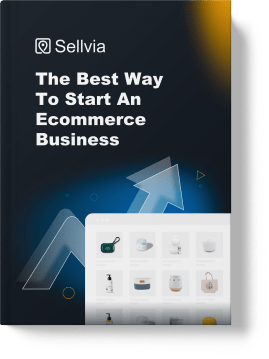Are you thinking about starting an ecommerce business in 2023? If so, you’re in luck! The world of ecommerce is constantly evolving, and the trends for the upcoming year are looking promising. With more and more people turning to online shopping, there’s never been a better time to launch your own ecommerce venture.
But where do you start? Building a successful ecommerce business requires careful planning, research, and execution. With so many options and strategies to consider, it can be overwhelming to know where to begin. That’s why we’ve put together this guide to help you get started.
Is starting an ecommerce business worth it? In this article, we’ll take you through the key steps involved in starting an ecommerce business in 2023.
We’ll cover things to consider when starting an ecommerce business. Everything from choosing the right products to sell, to building your brand, setting up your online store, marketing your business, and scaling your sales. So whether you’re a seasoned entrepreneur or a first-time business owner, read on to learn how to launch your own successful ecommerce business in 2023.
Choosing Your Ecommerce Business Model
Before starting an ecommerce business in 2023, it’s important to choose the right model for your goals and resources. There are several different types of ecommerce businesses to consider, each with its own benefits and drawbacks. Here are a few of the most popular options:
-
Dropshipping
In a dropshipping business, you act as the middleman between customers and suppliers. You don’t hold any inventory yourself; instead, you partner with a supplier who ships products directly to your customers. This can be a good option for entrepreneurs who want to start an ecommerce business without a lot of upfront investment.
-
Private Labeling
Private labeling involves creating your own brand of products and having them manufactured by a third-party supplier. This allows you to create unique products and build your own brand, without having to invest in manufacturing equipment or facilities.
-
Wholesaling
In a wholesaling business, you purchase products in bulk from manufacturers or distributors, and then sell them to retailers or directly to consumers. This can be a good option if you have a lot of storage space and can purchase products at a low cost.
-
White Labeling
Similar to private labeling, white labeling involves selling a product that’s already been produced by someone else, but under your own brand name. This can be a good option for entrepreneurs who want to sell high-quality products without having to create them from scratch.
Starting an ecommerce business on Amazon is as accessible as ever before! Try our ready solution.
When choosing your ecommerce business model, consider factors such as your budget, storage space, and ability to create or source unique products. Think about what type of business model will best allow you to achieve your goals and serve your target audience. By choosing the right ecommerce business model, you’ll set yourself up for success from the start.
Market Research and Validation
Once you’ve chosen your ecommerce business model, the next step is to conduct market research and validate your business idea.
Market research is the process of gathering information about your target market, competitors, and industry trends. By doing thorough market research, you can ensure that there’s a demand for your products and that you have a solid understanding of your target audience’s needs and preferences.
Here are a few key steps to take when conducting market research:
-
Identify your target audience
Who are the people you want to sell to? What are their demographics, interests, and purchasing behaviors? Conducting surveys or interviews with potential customers can be a great way to gather this information.
-
Analyze your competitors
Who else is selling similar products? What are their strengths and weaknesses? By analyzing your competitors, you can identify gaps in the market and find ways to differentiate your business.
-
Research industry trends
What are the current trends and developments in your industry? What changes or disruptions are on the horizon? By staying up-to-date on industry news and trends, you can adapt your business strategy to stay ahead of the curve.
Once you’ve conducted your market research, it’s important to validate your business idea before investing too much time and money into it. This means testing your products with potential customers to see if there’s a real demand for them. You can do this by setting up a landing page or social media account to gauge interest, or by conducting a small-scale test run of your products.
By taking the time to conduct market research and validate your business idea, you can reduce your risk of failure and ensure that you’re starting your ecommerce business on a solid foundation.
Creating a Business Plan
Before committing to anything, it’s important to write a solid business plan starting out an ecommerce website
. A business plan is a document that outlines your goals, strategies, and action plans for your business.
It helps you clarify your vision, identify potential challenges, and develop a roadmap for success
Here are a few key elements to include in your ecommerce business plan:
- Executive Summary: This is a brief overview of your business, including your mission statement, target market, and unique value proposition.
- Market Analysis: This section should provide an in-depth analysis of your industry, including your target audience, competitors, and market trends.
- Products and Services: Describe the products or services you’ll be selling, including their unique features, pricing, and manufacturing or sourcing process.
- Marketing and Sales Strategy: Outline your marketing and sales strategies, including how you plan to reach and engage your target audience, what channels you’ll use, and your sales projections.
- Operations and Logistics: Describe your business operations and logistics, including how you’ll handle fulfillment, shipping, and customer service.
- Financial Plan: This section should include financial projections, including startup costs, revenue forecasts, and cash flow projections.
Writing a business plan can be a time-consuming process, but it’s an essential step in launching a successful ecommerce business. It helps you identify potential challenges and develop a clear plan for achieving your goals. Once you’ve written your business plan, review it regularly and make updates as needed to keep your business on track.
Legal and Financial Considerations
When starting an ecommerce business, it’s important to take care of legal and financial considerations to ensure that your business is operating legally and protected from any legal disputes. Here are some key steps to take:
-
Register your business
Register your business with your state or country, depending on the laws of your jurisdiction. This will protect your business name and give you legal standing to operate as a business.
-
Obtain necessary permits and licenses
Depending on the type of products you’re selling, you may need to obtain certain permits or licenses to legally sell them. Check with your local or national authorities to find out what permits or licenses you may need.
-
Set up your accounting and financial systems
Setting up your accounting and financial systems is important to keep track of your business expenses and revenue, and to file your taxes accurately. Consider hiring an accountant or using accounting software to keep your finances in order.
-
Understand tax implications
As a business owner, you’ll need to understand the tax implications of running an ecommerce business. Depending on your location, you may need to collect sales tax from customers and file taxes for your business.
-
Protect your business with insurance
Consider purchasing business insurance to protect your business from any potential legal disputes or liabilities. This can include liability insurance, property insurance, and other types of coverage depending on your business needs.
Taking care of legal and financial considerations may not be the most exciting part of starting an ecommerce business, but it’s crucial to ensure that your business is operating legally and protected from any potential disputes. By taking the time to set up these systems and protections, you’ll be able to focus on growing and scaling your business with peace of mind.
Building Your Online Presence
Once you’ve established the legal and financial foundations for your ecommerce business, the next step is to build your online presence. Your online presence is your business’s digital footprint, and it’s crucial for attracting customers, building brand awareness, and driving sales.
Here are some key steps to starting an ecommerce business:
Step 1: Choose the Products You Want to Sell Online
The first step in starting an ecommerce business is to choose the products you want to sell online. Your products are the foundation of your business, and they will determine your target audience, marketing strategy, and revenue potential. Here are some key factors to consider when choosing your products:
-
What works right now with products and what doesn’t
It’s important to research current market trends and identify what products are in high demand. Look for products that solve a problem or fulfill a need for your target audience, and consider how you can differentiate your products from competitors.
-
How to find products to sell online
There are several ways to find products to sell online, including sourcing from manufacturers or wholesalers, creating your own products, or dropshipping from suppliers.
-
Do your research
Before committing to a product, it’s important to do thorough research to ensure that there’s a demand for it, and that you’ll be able to sell it profitably. Look at competitors, analyze pricing and profit margins, and research the target audience to make sure the product fits their needs.
Choosing the right products is crucial to the success of your ecommerce business. By identifying products that are in high demand, sourcing them from reliable suppliers, and pricing them competitively, you’ll be able to build a strong foundation for your business and attract a loyal customer base.
Step 2: Build Your Brand
Building a strong brand is essential for the success of your ecommerce business. Your brand is how customers perceive your business, and it plays a critical role in building trust, loyalty, and recognition. Here are some key steps to take when building your ecommerce brand:
-
The importance of branding in ecommerce
A strong brand sets you apart from competitors and helps you connect with your target audience. It creates a consistent look, feel, and voice for your business, and helps you build trust and credibility with customers.
-
Creating a strong brand identity
Your brand identity includes your logo, colors, typography, and tone of voice. It should be consistent across all of your marketing channels and reflect your business values and personality.
-
Tips for building brand awareness
There are several ways to build brand awareness, including social media marketing, influencer partnerships, content marketing, and email marketing. Identify which channels your target audience uses most and focus your efforts there.
Building a strong brand takes time and effort, but it’s a critical step in the success of your ecommerce business. By creating a strong brand identity and building brand awareness, you’ll be able to stand out in a crowded market and build a loyal customer base.
Step 3: Set Up Your Online Store
Once you’ve chosen your products and built your brand, it’s time to set up your online store. Your online store is where customers will browse and purchase your products, so it’s important to create a user-friendly, visually appealing website that’s optimized for conversions. Here are some key steps to take when setting up your online store:
-
Choose an ecommerce platform
Choose a platform that’s easy to use, customizable, and integrates with the tools and services you’ll need for your business.
-
Create your product pages
Your product pages are where customers will learn about your products and make purchasing decisions. Make sure to include clear, detailed product descriptions and high-quality images that showcase your products in the best light.
-
Set up your shopping cart and checkout process
Your shopping cart and checkout process should be user-friendly and optimized for conversions. Make sure to include multiple payment options, a clear and concise checkout process, and shipping and return policies.
-
Optimize your online store for SEO
Search engine optimization (SEO) is the process of optimizing your website and content to rank higher in search engine results pages. This can help you drive more organic traffic to your website and increase your visibility online.
-
Test and optimize
Once your website is up and running, it’s important to test and optimize it to improve conversions and user experience. Use A/B testing to test different page layouts, images, and calls-to-action, and make changes based on what’s working best.
By choosing the right ecommerce platform, creating compelling product pages, optimizing your checkout process, and testing and optimizing your website, you’ll be able to create a user-friendly, visually appealing online store that drives sales and revenue.
Step 4: Market Your Business
Marketing is a critical step in the success of your ecommerce business. It’s how you attract new customers, build brand awareness, and drive sales.
Here are some key steps to take when marketing your ecommerce business:
-
Identify your target audience
Your target audience is the group of people who are most likely to buy your products. Identify their demographics, interests, and purchasing behaviors, and tailor your marketing efforts accordingly.
-
Develop a marketing strategy
Your marketing strategy should include a mix of different channels, such as social media marketing, email marketing, influencer partnerships, and content marketing. Identify which channels are most effective for reaching your target audience and focus your efforts there.
-
Use paid advertising
Paid advertising, such as Facebook ads or Google Ads, can be a powerful tool for driving traffic and sales to your ecommerce website. Set a budget and target your ads to your ideal audience.
-
Build an email list
Email marketing is a cost-effective way to stay in touch with your customers and drive repeat sales. Build an email list by offering incentives for signing up, such as discounts or free shipping.
-
Measure and optimize
It’s important to measure the effectiveness of your marketing efforts and optimize them accordingly. Use analytics tools to track website traffic, conversions, and customer behavior, and make changes based on what’s working best.
Marketing is an ongoing process, and it requires consistent effort and optimization. By identifying your target audience, developing a marketing strategy, using paid advertising, building an email list, and measuring and optimizing your efforts, you’ll be able to build a strong online presence and drive sales and revenue for your ecommerce business.
Step 5: Scale Sales and Optimize Inventory Management
Once you’ve launched your ecommerce business and implemented your marketing strategy, it’s time to focus on scaling sales and optimizing inventory management. Here are some key steps to take when scaling your sales and managing your inventory:
-
Evaluate your sales channels
Analyze which sales channels are most effective for driving revenue, and focus your efforts there. Consider expanding into new sales channels, such as marketplaces or brick-and-mortar stores, to reach new customers and increase revenue.
-
Implement cross-selling and upselling strategies
Cross-selling and upselling are effective strategies for increasing average order value and driving more sales. Offer related products or upgrades at checkout or through targeted email campaigns.
-
Optimize your pricing strategy
Pricing is a key factor in driving sales and revenue. Analyze your competitors’ prices, adjust your prices based on customer demand, and offer discounts or promotions to increase sales.
-
Manage your inventory
Managing your inventory effectively is essential for meeting customer demand and avoiding stock outs or overstocking. Use inventory management software to track inventory levels, set reorder points, and manage stock across multiple sales channels.
-
Focus on customer retention
Repeat customers are more likely to make larger purchases and refer new customers to your business. Offer loyalty programs, personalized recommendations, and excellent customer service to build loyalty and increase customer retention.
Scaling your sales and optimizing inventory management are essential steps in the success of your ecommerce business.
By following these key steps, you’ll be able to create a strong online presence that drives traffic, builds brand awareness, and ultimately leads to more sales and revenue for your ecommerce business.
Final Thoughts
Starting an ecommerce business from scratch in 2023 is a thrilling and promising opportunity for entrepreneurs. With the right mindset, strategies, and execution, you can turn your passion into a thriving business that delivers value to your customers and generates revenue for yourself.
Remember that building a successful ecommerce business is a journey that requires dedication, creativity, and continuous learning. Take time to research your market, stay up-to-date with the latest trends and technologies, and develop a strong brand that resonates with your target audience.
As you navigate the challenges and opportunities of running an ecommerce business, remember to stay focused on your goals, be open to feedback, and be willing to pivot when necessary. With persistence and hard work, you can overcome any obstacles and achieve your dreams of becoming a successful ecommerce entrepreneur.
So, what are you waiting for? Starting an ecommerce business in 2023 is a wonderful opportunity for anyone. Book a call with our business advisors to take the leap and start building your ecommerce business today. With determination, innovation, and a little bit of luck, you can create a business that changes your life and makes a difference in the world. Good luck!










